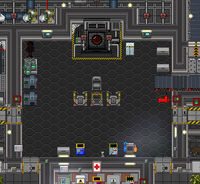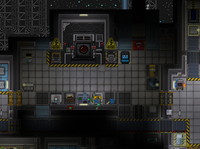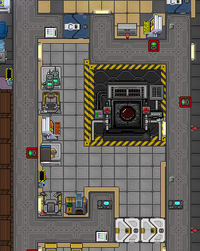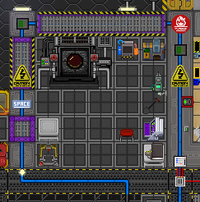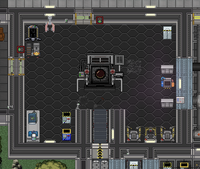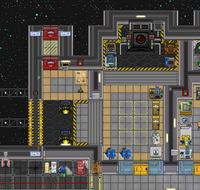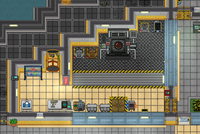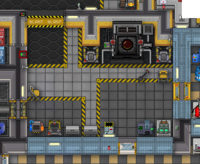Ore Processing: Difference between revisions
Studenterhue (talk | contribs) Adds some missing properties, gets rid of some ones that were wrong/don't exist now. No info on them just yet. |
Studenterhue (talk | contribs) Adds column with property value and corresponding material analyzer description, gives row headers |
||
| Line 91: | Line 91: | ||
== Properties == | == Properties == | ||
{{wip | {{wip | ||
|Reason=Update info on how each property works now and what each one influences | |Reason=Update info on how each property works now and what each one influences. | ||
}} | }} | ||
The material analyzer spits out a general description of the material and short list of properties and their specific numeric values. | The material analyzer spits out a general description of the material and short list of properties and their specific numeric values. | ||
| Line 97: | Line 97: | ||
'''Not all of these entries may be correct, be warned! If anyone has corrections to make, please do so!''' | '''Not all of these entries may be correct, be warned! If anyone has corrections to make, please do so!''' | ||
{| class="wikitable" | {| class="wikitable" | ||
!Property!! | ! Property | ||
! class="unsortable"| Explanation | |||
! width=25% class="unsortable"|Material Analyzer Descriptions | |||
|- id="Radioactivity" | |||
! Radioactivity | |||
| How much radiation the material puts off. The more radiation it emits, the more radiation damage you'll get when standing, holding, or wearing it. In power cells, this influences self-recharge rate. | |||
| | |||
{| style="font-size: 85%;text-align:left;margin: auto" width=100% | |||
! Value Range | |||
! Description | |||
|- | |- | ||
| | | 1 to 10 | ||
| "slightly radioactive" | |||
|- | |||
| 11 to 25 | |||
| "somewhat radioactive" | |||
|- | |- | ||
| | | 25 to 50 | ||
| "radioactive" | |||
|- | |- | ||
| | | 51 to 75 | ||
| "very radioactive" | |||
|- | |- | ||
| | | 76 to 90 | ||
| "extremely radioactive" | |||
|- | |- | ||
| | | 90+ | ||
| "impossibly Radioactive" | |||
|} | |||
|- id="Neutron Radioactivity" | |||
! Neutron Radioactivity | |||
| TBA | |||
| | |||
{| style="font-size: 85%;text-align:left;margin: auto" width=100% | |||
! Value Range | |||
! Description | |||
|- | |- | ||
| | | 1 to 10 | ||
| "glowing slightly blue" | |||
|- | |||
| 11 to 25 | |||
| "glowing somewhat blue" | |||
|- | |- | ||
| | | 25 to 50 | ||
| "glowing blue" | |||
|- | |- | ||
| | | 51 to 75 | ||
| "brightly glowing blue" | |||
|- | |- | ||
| | | 76 to 90 | ||
| "brilliantly glowing blue" | |||
|- | |- | ||
| | | 90+ | ||
| "blindingly glowing blue" | |||
|} | |||
|- id="Electrical Conductivity" | |||
! Electrical Conductivity | |||
| How well electricity passes through the material. | |||
| | |||
{| style="font-size: 85%;text-align:left;margin: auto" width=100% | |||
! Value Range | |||
! Description | |||
|- | |- | ||
|Reflectivity | | 1 to 14 | ||
| "highly insulating" | |||
|- | |||
| 15 to 30 | |||
| "insulating" | |||
|- | |||
| 31 to 45 | |||
| "slightly insulating" | |||
|- | |||
| 46 to 65 | |||
| "slightly conductive" | |||
|- | |||
| 66 to 76 | |||
| "conductive" | |||
|- | |||
| 77 to 85 | |||
| "highly conductive" | |||
|- | |||
| 86+ | |||
| "extremely conductive" | |||
|} | |||
|- id="Thermal Conductivity" | |||
! Thermal Conductivity | |||
| TBA | |||
| | |||
{| style="font-size: 85%;text-align:left;margin: auto" width=100% | |||
! Value Range | |||
! Description | |||
|- | |||
| 1 to 14 | |||
| "very temperature-resistant" | |||
|- | |||
| 15 to 30 | |||
| "temperature-resistant" | |||
|- | |||
| 31 to 45 | |||
| "slightly temperature-resistant" | |||
|- | |||
| 46 to 65 | |||
| "slightly thermally-conductive" | |||
|- | |||
| 66 to 76 | |||
| "thermally-conductive" | |||
|- | |||
| 77 to 85 | |||
| "highly thermally-conductive" | |||
|- | |||
| 86+ | |||
| "extremely thermally-conductive" | |||
|} | |||
|- id="Stability" | |||
! Stability | |||
| How likely the material is to break, safely or catastrophically, when struck by a regular attack. | |||
| | |||
{| style="font-size: 85%;text-align:left;margin: auto" width=100% | |||
! Value Range | |||
! Description | |||
|- | |||
| 1 to 10 | |||
| "very unstable" | |||
|- | |||
| 11 to 25 | |||
| "unstable" | |||
|- | |||
| 25 to 50 | |||
| "slightly unstable" | |||
|- | |||
| 51 to 75 | |||
| "slightly solid" | |||
|- | |||
| 76 to 90 | |||
| "solid" | |||
|- | |||
| 90+ | |||
| "very solid" | |||
|} | |||
|- id="Hardness" | |||
! Hardness | |||
| How much damage the material does if you whack someone with it. | |||
| | |||
{| style="font-size: 85%;text-align:left;margin: auto" width=100% | |||
! Value Range | |||
! Description | |||
|- | |||
| 1 to 10 | |||
| "very soft" | |||
|- | |||
| 11 to 25 | |||
| "soft" | |||
|- | |||
| 25 to 50 | |||
| "slightly soft" | |||
|- | |||
| 51 to 75 | |||
| "slightly hard" | |||
|- | |||
| 76 to 90 | |||
| "hard" | |||
|- | |||
| 90+ | |||
| "very hard" | |||
|} | |||
|- id="Density" | |||
! Density | |||
| How much damage the material does if you whack someone with it. | |||
| | |||
{| style="font-size: 85%;text-align:left;margin: auto" width=100% | |||
! Value Range | |||
! Description | |||
|- | |||
| 1 to 10 | |||
| "very light" | |||
|- | |||
| 11 to 25 | |||
| "light" | |||
|- | |||
| 25 to 50 | |||
| "somewhat light" | |||
|- | |||
| 51 to 75 | |||
| "somewhat dense" | |||
|- | |||
| 76 to 90 | |||
| "dense" | |||
|- | |||
| 90+ | |||
| "very dense" | |||
|} | |||
|- id="Flammability" | |||
! Flammability | |||
| TBA | |||
| | |||
{| style="font-size: 85%;text-align:left;margin: auto" width=100% | |||
! Value Range | |||
! Description | |||
|- | |||
| 1 to 10 | |||
| "very fireproof" | |||
|- | |||
| 11 to 25 | |||
| "fireproof" | |||
|- | |||
| 25 to 50 | |||
| "slightly fireproof" | |||
|- | |||
| 51 to 75 | |||
| "slightly flammable" | |||
|- | |||
| 76 to 90 | |||
| "flammable" | |||
|- | |||
| 90+ | |||
| "very flammable" | |||
|} | |||
|- id="Corrosion Resistance" | |||
! Corrosion Resistance | |||
| TBA | |||
| | |||
{| style="font-size: 85%;text-align:left;margin: auto" width=100% | |||
! Value | |||
! Description | |||
|- | |||
| 1 to 10 | |||
| "very corroded" | |||
|- | |||
| 11 to 25 | |||
| "corroded" | |||
|- | |||
| 25 to 50 | |||
| "slightly corroded" | |||
|- | |||
| 51 to 75 | |||
| "slightly corrosion-resistant" | |||
|- | |||
| 76 to 90 | |||
| "corrosion-resistant" | |||
|- | |||
| 90+ | |||
| "highly corrosion-resistant" | |||
|} | |||
|- id="Permeability" | |||
! Permeability | |||
| How well the material handles most chemicals. The lower the value is, the less likely it is that chems will reach you if splashed on you. | |||
| | |||
{| style="font-size: 85%;text-align:left;margin: auto" width=100% | |||
! Value Range | |||
! Description | |||
|- | |||
| 1 to 10 | |||
| "very impermeable" | |||
|- | |||
| 11 to 25 | |||
| "impermeable" | |||
|- | |||
| 25 to 50 | |||
| "slightly impermeable" | |||
|- | |||
| 51 to 75 | |||
| "slightly permeable" | |||
|- | |||
| 76 to 90 | |||
| "permeable" | |||
|- | |||
| 90+ | |||
| "very permeable" | |||
|} | |||
|- id="Reflectivity" | |||
! Reflectivity | |||
| How well the material throws back light. This primarily affects whether it can be used to make shiny things like golden IDs rather than how shiny it actually is in-game. | |||
| | |||
{| style="font-size: 85%;text-align:left;margin: auto" width=100% | |||
! Value Range | |||
! Description | |||
|- | |||
| 1 to 10 | |||
| "very dull" | |||
|- | |||
| 11 to 25 | |||
| "dull" | |||
|- | |||
| 25 to 50 | |||
| "slightly dull" | |||
|- | |||
| 51 to 75 | |||
| "slightly reflective" | |||
|- | |||
| 76 to 90 | |||
| "reflective" | |||
|- | |||
| 90+ | |||
| "very reflective" | |||
|} | |||
<!-- | <!-- | ||
|- | |- | ||
| Line 125: | Line 397: | ||
--> | --> | ||
|- | |- | ||
! Unique properties | |||
| Notes whether or not the material in question has anything special about it that doesn't fit under the other entries. This doesn't appear at all if there are no specialties to speak of. These can range from teleporting you randomly to color-shifting and so on. Experiment to see what does what! | |||
| {{N/a}} | |||
|} | |} | ||
Revision as of 06:46, 21 March 2021
| Ore Processing | |
| Location | |
|---|---|
|
Metallurgist's paradise. | |
|
Everybody | |
Ore Processing is the fine art of turning raw ores or metal bars into weird, fancy alloys and other interesting doohickeys using the arc smelter and nanofabs, typically in either the Refinery above Public Market or the mostly Miner-only derelict Mining Outpost.
| Ore Processing | |
| Location | |
|---|---|
|
Metallurgist's paradise. | |
|
Everybody | |
Turning raw ores or metal bars into weird, fancy alloys is possible with the help of an arc smelter. The public one (and the main subject of this guide) is located next to the cargo bay and above the warehouse. The mining department has access to another arc smelter tucked away in the derelict Mining Outpost.
| Ore Processing | |
| Location | |
|---|---|
|
Metallurgist's paradise. | |
|
Everybody | |
Turning raw ores or metal bars into weird, fancy alloys is possible with the help of an arc smelter. The mining department has access to one above their department and another smelter tucked away in the Mining Outpost.
| Ore Processing | |
| Location | |
|---|---|
|
Metallurgist's paradise. | |
|
Everybody | |
Turning raw ores or metal bars into weird, fancy alloys is possible with the help of an arc smelter. The "public" one (and the main subject of this guide) is tucked below the engine and the cargo bay. The mining department has access another arc smelter tucked away in the Mining Outpost.
| Ore Processing | |
| Location | |
|---|---|
|
Metallurgist's paradise. | |
|
Everyone | |
Ore Processing is the fine art of turning raw ores or metal bars into weird, fancy alloys using the public arc smelter in the Refinery near Cargo and all its myriad doohickeys and thingamajigs.
| Ore Processing | |
| Location | |
|---|---|
|
Metallurgist's paradise. | |
|
Everyone (go through the pod hangar) | |
Ore Processing is the fine art of turning raw ores or metal bars into weird, fancy alloys using the private arc smelter in Mining and all its myriad doohickeys and thingamajigs.
| Ore Processing | |
| Location | |
|---|---|
|
Metallurgist's paradise. | |
Ore Processing is the fine art of turning raw ores or metal bars into weird, fancy alloys using the private arc smelter in Sea Turtle's refinery area and all its myriad doohickeys and thingamajigs.
| Ore Processing | |
| Location | |
|---|---|
|
Metallurgist's paradise. | |
|
Everyone | |
Ore Processing is the fine art of turning raw ores or metal bars into weird, fancy alloys using the public arc smelter in Mining and all its myriad doohickeys and thingamajigs.
So fucking metal!
The devices scattered around the room are as follows:
Arc Smelter: This giant contraption in the back of the room is where dreams are made. Simply insert a material into the smelter by clicking it with the desired material in your hand, then click the smelter with an empty hand to refine that material into an alloy bar, then click it again to retrieve the bar. Up to two materials can be loaded to make a combination alloy that combines the functionality of both materials (i.e. combining a metal and a crystal will have it be recognized as both metal and crystal). Note that every use of the smelter causes slag to build up inside of it which, if not removed, will decrease the quality of each successive alloy and cause smoke to billow out of the smelter until it's fixed. Remove slag by clicking the smelter with the slag shovel. Most compatible materials are listed here, though you can also use obscure things like the removed slag, gold or even human flesh with a willing donor. Experiment!
Material Processor:The rectangular-looking thing with two little horizontal claws. This is where you can insert ores, gems, and other various raw materials, and get ingots, blocks, and clumps of processed materials for use in the smelter or nano-fab.
Nano-Fabricator: The thing with the 2 little upright limbs. This is where you insert your alloy bars to make stuff. Most schematics require either metal alloys, fabrics, rubber, leather or crystals. A single bar can be made to fill all needs.
Material analyzer: The hand-held devices on the table next to the general manufacturer can scan and tell you all sorts of info about a material such as its hardness, electric conductivity, etc. You can use it on most materials as well as most things made with the smelter and fabricators.
General Manufacturer: These are found all over the station, really. As you'd expect from the name they're supposed to be used for producing general objects, but in Ore Processing it's more for material storage so people don't dump a huge mess of materials all over the room. Comes with a couple bars worth of mauxite, pharosium and molitz to get you started.
Properties
| This page is under construction. The following information may be incomplete. Update info on how each property works now and what each one influences. |
The material analyzer spits out a general description of the material and short list of properties and their specific numeric values.
Not all of these entries may be correct, be warned! If anyone has corrections to make, please do so!
| Property | Explanation | Material Analyzer Descriptions | ||||||||||||||||
|---|---|---|---|---|---|---|---|---|---|---|---|---|---|---|---|---|---|---|
| Radioactivity | How much radiation the material puts off. The more radiation it emits, the more radiation damage you'll get when standing, holding, or wearing it. In power cells, this influences self-recharge rate. |
| ||||||||||||||||
| Neutron Radioactivity | TBA |
| ||||||||||||||||
| Electrical Conductivity | How well electricity passes through the material. |
| ||||||||||||||||
| Thermal Conductivity | TBA |
| ||||||||||||||||
| Stability | How likely the material is to break, safely or catastrophically, when struck by a regular attack. |
| ||||||||||||||||
| Hardness | How much damage the material does if you whack someone with it. |
| ||||||||||||||||
| Density | How much damage the material does if you whack someone with it. |
| ||||||||||||||||
| Flammability | TBA |
| ||||||||||||||||
| Corrosion Resistance | TBA |
| ||||||||||||||||
| Permeability | How well the material handles most chemicals. The lower the value is, the less likely it is that chems will reach you if splashed on you. |
| ||||||||||||||||
| Reflectivity | How well the material throws back light. This primarily affects whether it can be used to make shiny things like golden IDs rather than how shiny it actually is in-game. |
| ||||||||||||||||
| Unique properties | Notes whether or not the material in question has anything special about it that doesn't fit under the other entries. This doesn't appear at all if there are no specialties to speak of. These can range from teleporting you randomly to color-shifting and so on. Experiment to see what does what! | N/A |
The Nano-Fabricator
At the top of the interface, there are 3 tabs.
- Blueprints: A list of items the fabricator can make
- Materials: This is where you can see all the components and supplies that are in the machine, available for your arts and crafts
- Setting: Not much to it, but you can set it to automatically store crafted items into the Materials tab. This is useful when making components for more complex items.
| This page is under construction. The following information may be incomplete. Describe how material used affects the space suit set and material sheets, confirm that material used has no effect on the properties of the bow. |
At the Nano-Fabricator you can make a lot of that cewl stuff.
| Product | Category | Requirements | Description |
|---|---|---|---|
| Spear | Weapons | (3) Metal (1) Arrowhead |
A simple spear with long reach. The Hardness stat of the arrowhead used determines the damage of the spear. Somewhat buggy to use: click on the tile directly in front of you on help intent to stab ahead with it. |
| Arrow | Weapons | (1) Arrowhead (1) Metal |
A simple arrow used as ammunition for bows. Can be poisoned. Arrows that hit people implant into their chest, so you can make i.e. cerenkite arrows that irradiate people, telecrystal arrows that cause people to teleport around, etc. |
| Bow | Weapons | (3) Metal or Organic | A simple bow. Fired similarly to a standard gun, but you need to hold down the LMB on where you want to fire to get a more accurate shot. The material of the bow has seemingly no effect. |
| Quiver | Weapons | (2) Cloth or Rubber | A quiver for arrows. Goes on your back(you'll need to have it there to use a bow properly). |
| Glasses | Clothing | (1) Crystal | A pair of non-corrective glasses. Sadly do not change the color of your vision. |
| Jumpsuit | Clothing | (3) Cloth or Organic | A custom made jumpsuit. Has no special properties. |
| Insulating gloves | Clothing | (2) Cloth or Organic | Custom insulating gloves. Inherits thermally and electrically insulating properties. |
| Armored gloves | Clothing | (2) Cloth or Organic | Custom armored gloves. Inherits physical properties like toughness and hardness. |
| Shoes | Clothing | (2) Cloth or Organic or Rubber, (2) Material, (2) Optional Materials | Generic shoes. Material chosen for Sole (and optional Toe Tip) are just for style, but material for Upper Part influences certain properties; it can give an extra bonus to kicking attacks (regular kicks and dive kicks) based on (density * hardness)/2500, the shoes can protect you from protect you from 1.65 * (100 - thermal conductivity) and give you 0.1 * (100 - thermal conductivity) heat and cold resistance.
|
| Flashlight | Lights | (1) Metal (1) Lens |
A simple flashlight. Light color is affected by lens color. |
| 5 Light tubes | Lights | (1) Metal (1) Lens |
5 replacement light tubes. Lens color affects light color. |
| 5 Light bulbs | Lights | (1) Metal (1) Lens |
5 replacement light bulbs. Lens color affects light color. |
| 5 Tripod bulbs | Lights | (1) Metal (1) Lens |
5 replacement tripod light bulbs. Lens color affects light color. |
| Material Sheets (10) | Tools | (1) Metal or Crystal | Ten sheets for construction purposes. |
| Small energy cell | Tools | (2) Energy | A custom small power cell used in energy weapons. The more conductive the material used, the higher the capacity. Self-recharging cells are possible, though they will typically charge very slowly unless you get radioactivity high. |
| Large energy cell | Tools | (4) Energy | A custom power cell, like those used in APCs and Cyborgs. As with small cells, higher conductivity creates higher capacity cells, and self-recharging cells can be crafted if radioactive materials are used, with higher radioactivity creating higher charge rate. |
| Nuclear Fuel Rod | Tools | (1) Fissile | Currently has no use. |
| Advanced Nuclear Fuel Rod | Tools | (3) Fissile, (1) Radioactive Material | Currently has no use. |
| Small Coil | Components | (1) Metal | A small coil used in various objects. |
| Large Coil | Components | (2) Metal | A large coil with current no use. |
| Arrowhead | Components | (1) Metal or Crystal | An Arrowhead that can be used for arrows or in other objects. |
| Lens | Components | (1) Crystal | A Lens used as a component in various objects, such as the nano-fab bulbs and the antique laser gun. |
| Gears | Components | (1) Metal | Some gears used as parts in various objects. |
| Tripod | Components | (1) Metal | A tripod. Like the ones at the Space Pod beacons. |
| Armor plates | Components | (1) Metal | Armor plates used in various objects. |
| Instrument body | Miscellaneous | (4) Material | The body of an instrument. |
| Instrument neck | Miscellaneous | (3) Material | The neck of an instrument. |
| Instrument mouthpiece | Miscellaneous | (2) Material | The mouthpiece of an instrument. |
| Instrument bell | Miscellaneous | (4) Metal or Crystal | The bell of an instrument. Not an actual bell. |
| Instrument bag | Miscellaneous | (4) Cloth or Organic | The bag of an instrument. |
| Instrument rod | Miscellaneous | (3) Metal or Crystal | A plain old hollowed out rod. |
| Infusion | Refining | (1) Chemical, (10) Unprocessed Material, (1) Starstone | Whatever chemical you infuse the materials with causes items made of that material in the Nano-Fabricator to constantly inject that chemical into whoever is holding/wearing that item. Infuse omnizine or meth into clothing to give you a big advantage in combat, or something like Honkfartium to maintain its silly effects for an indefinite duration. |
| Space Suit Set | Clothing | (3) Cloth or Organic or Rubber, (3) Metal, (2) Crystal | A space suit and helmet set, very much like the ones in EVA |
Great! So what can I make with all that stuff?
| This page is under construction. The following information may be incomplete. Add more uses for the material system and the items created by the nanofab. |
- You can attach instrument pieces to each other in an attempt to make an actual instrument.
- Small coils and lenses can be used in the construction of the antique laser gun, though as of yet large coils have no use.
- Tripods and their respective bulbs can be used to make standalone light fixtures. They also double as a handy barricade.
So where do I get all the stuff I need?
| This page is under construction. The following information may be incomplete. Add more materials and info about their sources, uses, and special/unique properties. |
Good question! You can gain plenty of materials for your smeltery needs by asking the Miners for them, since their job is entirely about digging them up from rock. If there aren't any miners, don't worry. There's still plenty of materials that can be obtained through other means.
Alloys
| Name | Image | Classification | Description |
|---|---|---|---|
| Steel | Sturdy Metal | The processed equivalent of mauxite, made with char and mauxite. | |
| Electrum | Metal, High Energy Conductor | A gold-cobryl alloy excellent at conducting electricity. | |
| Soulsteel | Metal, Power Source | Steel alloyed with Discount Dan's secret ingredient: human souls! Or at least, a more malleable form of them in form of ectoplasm ran through the material processor. Objects made from soulsteel, as well as alloys of it (so long as the soulsteel isn't too "diluted") can be piloted by Ghosts. | |
| Hauntium | Cloth/Fabric, Metal, Power Source | Blend steel with souls with eldritch koshmarite, and you get a cloth that's highly electrically insulating and very impermeable. Similar to soulsteel, Ghosts have a chance to possess and start piloting objects made from hauntium when moving over them. | |
| Plasmasteel | Metal, Dense Metal | Steel combined with plasmastone, dramatically raising its density. | |
| Dyneema | Cloth/Fabric | A futuristic spidersilk-carbonfiber polymer that offers dramatic protection from melee and ranged attacks. | |
| Neutronium | Extraordinarily Dense Crystalline Matter, Power Source | Has excellent electrical conductivity and one of the densest materials out there, but it emits highly deadly neutron radiation. Recipe is secret. To make it, consider some of its properties, and how neutronium might form in real life... kinda. |
Other
| Name | Image | Classification | Description |
|---|---|---|---|
| Starstone | Extraordinarily Dense Crystalline Matter | Extremely valuable, but can only be found in certain highly-dangerous Z5 asteroids, extremely rare starstone asteroids located by the quantum telescope, and the remains of meteor showers. Sell them to certain merchants to become an instant millionaire! Can also be used to infuse chemicals into metals and alloys. | |
| Slag | Metal, Sturdy Metal | By-product of smelting and a low-quality substitute for mauxite. | |
| Glass | Crystal | The processed equivalent of molitz. | |
| Gnesis/Translucent Gnesis | Dense Metal, Crystal, High Energy Conductor, Reflective Material | Flockmind metal. As good a conductor as electrum, with a neat teal color too. Can be, obviously, obtained from smashing converted tiles, as well as somewhere in deep space. | |
| Iridium-Alloy | Metal, Dense Metal, Sturdy Metal | The Syndicate's pride and joy. Ridiculously strong (80 hardness and density); can be dropped from Nanite swarms in their respective asteroids, and a certain secret source. | |
| Carbon Nanofiber | Conductor, Cloth/Fabric | Jack of all stats, and nearly a master of all. Not only is it super dense and super hard, yet surprisingly permeable, but it's also excellent at conducting electricity and heat alike. Sec's armor vests can be reprocessed into these, and they can be found in nanite clusters, super-rare Quantum Telescope "asteroids" that house huge swarms of angry nanobots. | |
| Ectofiber | Conductor, Power Source, Cloth/Fabric | Ghost hair. A surprisingly good material for custom power cells, but you need a special weapon to obtain it, and just finding it is a quest. | |
| Coral | Metal, Crystal, Fabric/Organic | A surprisingly versatile mineral cut from the coral outside Oshan Laboratory. Makes a lovely, royal purple color. | |
| Ectoplasm | Power Source | Don't think too hard about the implications of using a piece of a ghost for power. Its stats are abyssmal, but it's a relatively easy-to-obtain power source for manufacturer requirements and can used for neat stuff like soulsteel. Appears when enough ectoplasm reagent is poured onto a surface, when Wraiths choose to spawn ectoplasm through the Poltergeist ability, and when a ectoplasmic destabilizer successfully de-hairs a ghost. | |
| Space Spider Silk | Fabric/Organic | Obtained by butchering spiders of any kind, ice, clown, cluwne, or just regular. | |
| Beeswax | Organic | The result of putting honey into a material processor, beeswax is rather soft and not very dense. |
Alright, I got all that. Now how do I become indestructible?
Indeed, no crafting system is without a few advanced tricks. Here are some things to know:
- When you combine two materials, their stats average out. Let's say one material had a Hardness of 3 and another had 7; if you mixed them, the combined alloy would have a Hardness of 5.
- Merged materials will take on a mix-and-match name of whatever you put in, starting with the name of the first material and ending with the second. Additives will have their full name prefixed before the alloy name.
- If you're clever with the material order, you can cram all sorts of things into an alloy and then revert it to a base name. Make a jumpsuit out of starstone but prefix it with slag, no one can tell the difference without the Material analyzer! A very devious yet underused trick.
- Once a material is smelted into an alloy bar, that bar will keep the material's typing and quirks forever regardless of how many reforges it goes through. You could fuse whatever you want into a telecrystal and it would always have its spastic warping properties, you could pump a hundred ultra-dense uqill into fibrilith and it would still be considered a fabric, etc.
- This does not work with additives however, so make sure to apply the additive last!
- Need one alloy for its typing/effect but desire another alloy's stats? Grab as much of the desired alloy as you can find and gradually pump it into the base alloy. The increasing stat average will push the numbers of the final product up to where you want them to be.
- This doesn't work as well if you're doing this wanting the stats of more than one alloy, but some increases are still better than nothing!
Evil Blacksmith
So you're a traitor? Unfortunately, the days of blowing up huge chunks of the station with explosive pods and rampaging in nigh-impenetrable heavy armor are long, long gone, but that doesn't mean you can't use your blacksmithing skills for nefarious ends! This time, the true strength of material science is less about raw power and more about unique gimmicks you can pull off.
If you can somehow get your hands on erebite, you're in luck. Erebite is an evil blacksmith's best friend, because it's so damn useful. Erebite ore tends to make a powerful explosion from so much as being looked at wrong: the slightest impact, be it from smacking, throwing, heating, electrifying or explosion knockback has a chance to make it go off, and the chance increases as its durability decreases. This extends to anything you make out of it or mix with it, so smelting a single erebite bar into a stack of metal gives you ten easy pipe bombs (possibly more if you make the stack into floor tiles!).
...There's just one catch though: in addition to being the most radioactive material in the game, erebite can sometimes explode from being put in the smelter to begin with. That's how volatile this shit is. Make something that resists explosions and/or radioactivity before handling erebite, or your traitor round could end prematurely. Don't say we didn't warn you.
Explosive floor tiles and chairs aren't the only things you can make with the nano-fab. You can also craft spears and arrows, so you can go medieval on the crew's asses. By absolutely no means are they the deadliest or even the most reliable weapons you can wield (bows in particular are rather unpredictable), but there's still something hilarious about teleporting someone into Space with a telecrystal-tipped spear or blowing a poor schmuck into absolute smithereens with a carefully-aimed erebite arrow. You can even dip your arrows in up to three units of your favorite hellmix for extra hilarious effect.
Or, perhaps you want to be visible, but explosions are too crude for you, and you're not the kind to enjoy jabbing people with spears and arrows. There's an easy alternative: build some material sheets, replace a room/hallway, floor, windows, walls and all, with your alloy/material of choice, and make the station itself your weapon. Build them out of telecrystal for a chance to warp people to a random spot with every step, making the hallway of choice nearly impossible to navigate. Or make them out of erebite and cerenkite, so that each step they take douses them with a deadly dose of radiation. For extra fun, coat the floors into it with water or space lube or construct a graviton trap. The fun never ends!
| Department Guides | |
|---|---|
| Engineering | Making and Breaking · Construction · Gas · Power Grid · Thermoelectric Generator · Singularity Generator · Geothermal Generator · Catalytic Generator · Nuclear Generator · Mining · Materials and Crafting · Wiring · Hacking · MechComp · Mechanic components and you · Control Unit · Ruckingenur Kit · Reactor Statistics Computer · Cargo Crates |
| Medsci | Doctoring · Genetics · Robotics · Telescience · Plasma Research · Artifact Research · Chemistry · Chemicals · ChemiCompiler · Decomposition |
| Security | Security Officer · Contraband · Forensics · Space Law |
| Service | Foods and Drinks · Botany · Writing · Piano Song Dump · Instruments |
| The AI | Artificial Intelligence · AI Laws · Chain of Command · Guide to AI · Humans and Nonhumans · Killing the AI |
| Computers | Computers · TermOS · ThinkDOS · Packets |
